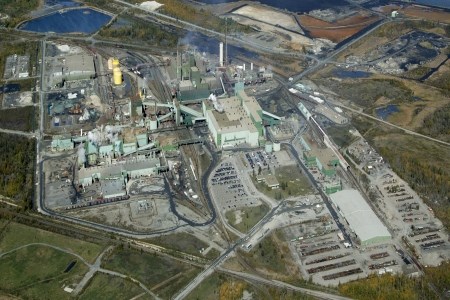Xstrata's Kidd Metallurgical Site in Timmins is coming down.
Built in 1980 and shuttered in early 2010, the last smelter to be built in Canada was initially slated to be razed late this spring. Its demolition date has since been moved up to as early as February, dashing the hopes its relatively modern infrastructure would play a part in restoring some of the 670 jobs lost following the site's closure.
"My hope was that we'd have a couple more months to give this a better shot to put players in place," said Mayor Tom Laughren.
"Over and above this, we do know that there are some opportunities from a brownfield perspective. We know there is potential for something else as it relates to that site, and that's what we've got to focus on."
While the smelter and zinc plant will be demolished, the concentrator will remain, as it continues to play a role in processing ore from the nearby Kidd Mine. This is due to remain in operation until 2018, when the mine is expected to close.
This means the results of a study commissioned by the city to find alternate uses for the location, due to be released in the coming weeks, will not be impacted. One of the two scenarios being developed in the study is predicated on the use of the concentrator for processing magnesium, while the other scenario looked at the site's use as a brownfield location with access to rail and a variety of services.
This study remains a point of hope for city officials as a means of eventually helping to offset the loss of taxes to city coffers, which Laughren said was likely part of the reason for moving up the demolition date. The Met Site provided $4 million annually to Timmins tax rolls -- a significant loss to the city, said Laughren.
Although aware of the request for site acquisition and demolition bids on the part of Xstrata, Laughren says the community's hope was that a last-minute white knight would have emerged to champion the site.
"At the end of the day, our hope was that somebody, out of the blue, would maybe come out of the woodwork with a good plan that Xstrata would look at, and whether that happened or not, I don't know."
"Sometimes we forget we don't own that site; Xstrata owns it. They've got the liabilities for the site and the building."
What this means for Timmins' role in the potential processing of Ring of Fire chromite ore is unclear.
The infrastructure at the Met Site has been identified by various parties as perhaps being able to play a role in that work, something which has been openly coveted by communities throughout the North.
Timmins in particular has been identified specifically as a prime location by any number of parties, including Teamsters Union president William Brehl, who pointed to rumors that the processing would be instead done in China.
"At Nakina, CN should take the materials east, not west, to the Algoma Central Railway, which CN owns, then north to ONR (Ontario Northland Railway) and on to Timmins," said Brehl in a release.
"The infrastructure is there. The trained workforce is there. The housing is there. The plant is there. All that is needed is the will of politicians to insist that business leaders do this instead of sending it all off to China."




